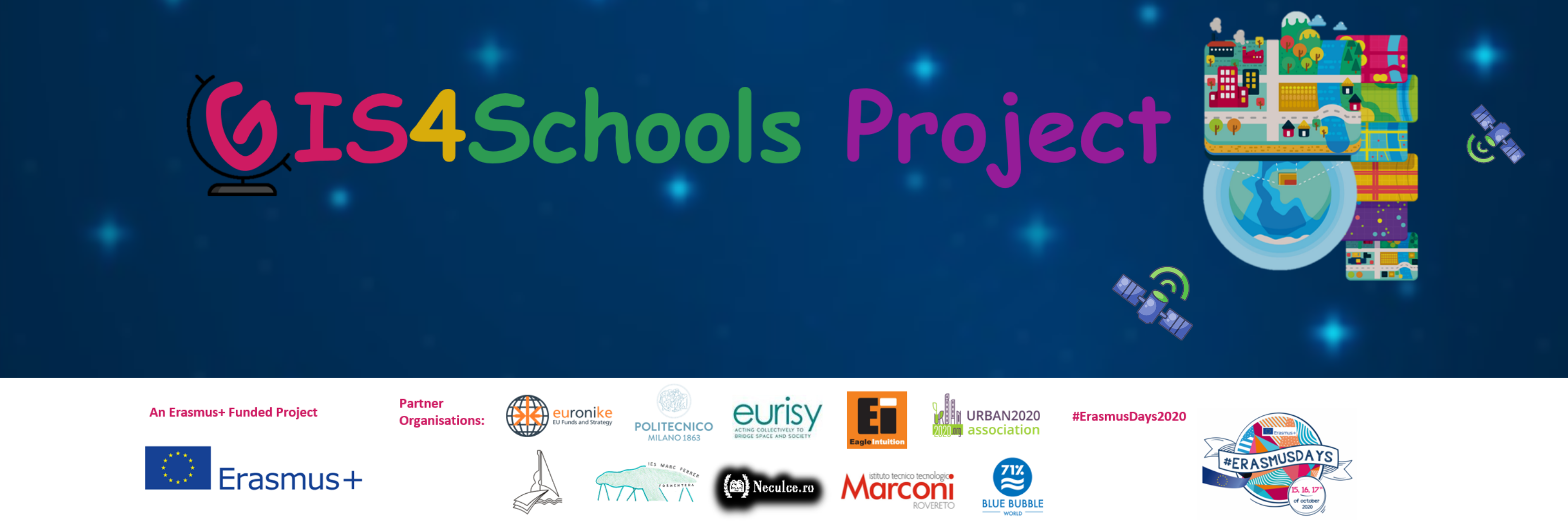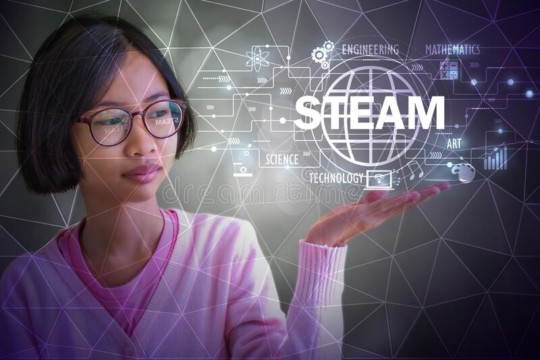GIS4Schools: Improving STEAM Education in Secondary Schools

STEM (Science, Technology, Engineering and Mathematics) subjects play an important role in consolidating scientific knowledge in the society and in sensitising young generations to the importance of science for economic and social development. The attention towards an increasing enrolment in STEM education to stimulate the curiosity of students and create new opportunities for their future is part of the UNESCO’s Agenda 2030 and the United Nations Sustainable Development Goals- specifically SDG 4- Quality Education. [1]
In recent years, the relevance of STEM subjects has become more prominent, mostly due to the impact these subjects have on the labor-market. Nevertheless, in Secondary Schools, STEM subjects are not always part of the educational curricula. The lack diversity in the offer may decrease pupils’ motivation in further pursue a STEM academic paths, which are often perceived as too hard, and the pupils do not feel skilled enough to pursue a career in this sector. [2]
In addition to this, another relevant aspect characterizing STEM subjects are the existence of a gender gap. Even if nowadays an increased number of girls have access to education than ever before, they often still do not have the same opportunities to choose, complete and benefit from a carrier in STEM. Girls and women are under-represented in STEM education and careers. According to the UNESCO report “Cracking the code: Girls’ and women’s education in STEM”, only 35% of STEM students are women. This percentage is quite alarming, considering that the future job market will be oriented towards more STEM careers. [3]
Based on the relatively low appealing of STEM curricula among students, some schools have begun to offer an evolved concept: the STEAM. STEAM-based curricula are not just focused on scientific concepts, but characterised by a learning approach using Science, Technology, Engineering, Mathematics and Arts to stimulate students’ critical thinking, dialogue exchange and understanding.
Currently both STEM and STEAM education represents a strategic priority for the European Union in the field of education and training.
According to the OECD Programme for International Student Assessment (PISA) report 2018, more than 1 in 5 pupils in the European Union has insufficient proficiency in reading mathematics or science.[4] STEAM learning modules, especially in secondary schools proved their ability to nurture the curiosity and cognitive resources of students, providing them with the right tools to understand the complexity of the world and face the challenges that the current times are posing, like climate change, among many others. Future generations represent a juncture between the growing understanding of the potential hazardous impact of climate change on society and local communities and the need to address those challenges with concrete actions on a daily basis. STEAM education is thus key to equip students with the necessary tools to act to favor a sustainable transition towards a greener and more resilient environments. Preparing these future generation means also endow them with a new set of skills to train future professionals to access a more and more competitive job market in which technology and science play an increasingly significant role.

The project
The improvement of STEAM education in secondary schools is the core objective of the Erasmus+ funded project “GIS4Schools”, which started in September 2020 and ends in June 2023, but poised to unfold its effects for a way longer time.
GIS4Schools relies on the support of a transnational and multi-stakeholders’ partnership composed by:
- Four secondary schools ITT Marconi (Italy), Escola Secundária José Afonso (Portugal), Colegiul National Ion Neculce Bucuresti (Romania), and IES Marc Ferrer (Spain);
- One technical university: the Politecnico di Milano (POLIMI) (Italy)
- One training teaching centre: Eagle Intuition (Portugal)
- Four European and National Associations active in the field of Education, Space, Resilience and Climate Change: Eurisy (France), Euronike (Italy), Urban 2020 Association (Romania) and Blue Bubble World (Spain).
In total, 24 teachers and 180 pupils will be involved in the project, while 200 teachers and 1000 pupils will be indirect beneficiaries of the project’s outputs.
GIS4Schools aims at promoting a new innovative approach to foster the teaching of STEAM subjects in secondary schools. This objective will be achieved by allowing pupils to learn about GIS technology and how to use it to respond to climate change challenges. For the first time, high schools’ pupils will have the opportunity to use satellite data at school. The data will be provided by the European Earth Observation Programme Copernicus, and it will be used to help the pupils in the co-creation process of GIS-based products.
The Intellectual Outputs
The methodology that will be adopted by the teachers is the result of a combination of Inquiry-Based Science Education (IBSE), and Problem-Based Learning Approach (PBL) adapted to the teaching of science subjects.
During the project, three main tools will support the efforts of the teachers and will guide the pupils to the final goal of selecting one specific challenge climate change is posing to their community and provide through GIS powered tools an idea for concrete action to be undertaken to minimise the effects. The case studies will be included in a final report to be developed by each selected students’ class.
The training packages have a critical importance for both teachers and pupils: teachers will learn which methodology and pedagogic approach have to be adopted to transfer the new knowledge and to transfer it. While, pupils will acquire new competencies such as data visualization, GIS and Analysis tools, EO and Imagery Analysis, and Geospatial Data Management related to climate change and related hazards using Copernicus data. The training package will be built and designed by the POLIMI based on their extensive experience and expertise in transferring knowledge on the use of GIS-based software. It will include guidelines, exercises and simulations and it will be illustrated during an intensive four days professional training course.
A suite of open source GIS products co-created with pupils’ involvement on the topic of climate change. The methodology that will be adopted is a learning-by-doing approach. The process of co-creation of a final GIS-based product will increase the student’s knowledge of all the technicalities behind each development phase whilst deepening their understanding of climate change.
E-Learning platform and Open Source Repository. Having the opportunity of collecting, storing and sharing the knowledge of the pupils has a double dimension. On one side, an e-learning platform and open-source repository would facilitate the interactions among the schools participating in the project, especially today where distance learning represents a valid option to protect the pupils from COVID-19 risks. On the other side, the repository and the e-learning platform represent an incredible source of information for those pupils and teachers, not participating in the project but interested in implementing STEAM curricula in their schools in the future.
Impact
The main expected impacts of the GIS4Schools project are centred on boosting STEAM’s knowledge in Secondary Schools while increasing teachers’ and students’ familiarity and acquisition of new skills in STEAM disciplines teaching, both in terms of content and of methodologies. Furthermore, the project aims at impacting on:
- Pupil’s environmental awareness while working on local case studies;
- Pupils’ civil engagement and responsible citizenship by developing a sample solution to respond to local challenges;
- Innovative pedagogical modules on GIS and climate change not yet covered by the traditional educational curricula.
GIS4Schools aims at providing the pupils with all the tools they need to observe and change the world around them.
Eurisy in the GIS4Schools project
Eurisy participates in the GIS4Schools project as leader of communication and dissemination work package. Communications activities are key to engage the students proving them with the motivations to feel the ownership of the projects and the results achieved; to ensure a smooth and transparent knowledge-sharing of the projects’ activities and its main deliverables by all the partners, and eventually to raise awareness towards relevant stakeholders and a wider audience of the benefits of such a project for their community.
Besides, given the high innovation potential of the project itself a targeted communication and dissemination towards external entities is necessary to enhance and maximise at European level the benefits of such projects to stimulate a wider uptake of such STEAM curricula.
To achieve those objectives Eurisy is developing a dedicated website to be used as the main channel for the projects’ news.
Stay tuned more is yet to come!
Follow us to know more about the future initiatives of GIS4Schools on Facebook, Twitter, LinkedIn and Instagram, or sign up to the newsletter!
The recording of the GI4Schools introductory webinar is available here.
[1] Horizon2020 Project, Perform- The Art of Science Learning. January 2017. http://www.perform-research.eu/wp-content/uploads/2016/07/D5.1-Sustainability-Plan-1.pdf
[2] S. Stolton, The future for STEM in Europe, Euractiv, July 6th 2020. https://www.euractiv.com/section/digital/linksdossier/the-future-for-stem-in-europe/
[3] United Nations Educational Scientific and Cultural Organization, Girls’ and women’s education in science, technology, engineering and mathematics (STEM). https://en.unesco.org/stemed
[4] OECD Programme for International Student Assessment (PISA), 2018. https://www.oecd.org/pisa/publications/pisa-2018-results.htm
